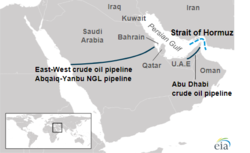In a dramatic escalation that could have far-reaching consequences for global energy markets and regional stability, Iran has closed the Strait of Hormuz, a critical maritime chokepoint through which nearly one-fifth of the world’s oil supply transits daily. This bold move comes amid rising tensions between Iran and Western powers, following weeks of threats and military posturing in the Gulf.
The Strait of Hormuz, long considered one of the world’s most strategically vital waterways, is now at the heart of an unfolding geopolitical crisis that could destabilize the region and send global oil prices skyrocketing.
What Is the Strait of Hormuz?
Often referred to as the Hormuz Strait, the narrow waterway lies between the Persian Gulf and the Gulf of Oman. At its narrowest point, the Strait of Hormuz is just 21 miles wide. Yet, it is one of the most important global oil arteries. Each day, approximately 20 million barrels of oil pass through it — about 30% of all seaborne-traded crude oil.
Major oil-producing nations such as Saudi Arabia, Iraq, the United Arab Emirates, and Kuwait rely heavily on this route to export crude to global markets, particularly in Asia and Europe. The closure of the Iran Strait of Hormuz sends an immediate ripple through global logistics and energy sectors.
Why Did Iran Close the Strait?
According to Iranian officials, the decision to close the strait comes in response to “continued acts of aggression” by the United States and its allies. The Iranian Revolutionary Guard Corps (IRGC) claimed responsibility for enforcing the closure, citing foreign interference, increased U.S. naval presence in the Gulf, and Western sanctions as the catalysts.
In a statement broadcast on Iranian state media, a senior commander said, “Until our sovereignty and national security are fully respected, Iran will keep the Strait of Hormuz closed.” The commander emphasized that the closure is not intended to provoke war but to “protect Iran’s economic and territorial integrity.”
This is not the first time Iran has threatened such a move. Over the past decade, the Iran Hormuz Strait issue has flared up whenever tensions with the West rise. But this time, the government has acted — physically blocking passage through the waterway with military vessels and mines, according to regional news agencies.
Global Reaction to Iran Closing the Strait of Hormuz
The international community has responded with alarm and urgency. The United Nations Security Council convened an emergency session, while NATO called the closure “an aggressive disruption to the free flow of commerce.” The United States Department of Defense confirmed the mobilization of additional naval forces to the region, with a focus on restoring safe passage through the Strait of Hormuz.
U.S. Secretary of State issued a warning: “Iran’s actions jeopardize not only regional peace but the entire global economy. We are working with allies to reopen the Strait immediately and unconditionally.”
Oil prices spiked nearly 10% within hours of the news breaking, and energy analysts predict that if the closure persists, crude oil could breach the $150-per-barrel mark — levels unseen since the 2008 financial crisis.
Implications for the Global Oil Market
With the Strait of Hormuz closed, oil-exporting countries that depend on the strait to reach international buyers are in crisis mode. The UAE and Saudi Arabia are exploring alternate overland routes, but none are capable of matching the volume the Hormuz Strait typically handles.
Insurance premiums for tankers operating in the Gulf have also surged, as the region is now considered a war risk zone. Major shipping companies have rerouted their fleets or paused operations altogether, fearing Iranian retaliation or miscalculation that could lead to direct conflict.
This incident highlights the vulnerability of global supply chains to geopolitical shocks. The dependency on a single maritime passage underscores the need for diversification in global energy transport infrastructure.
Regional Escalation or Strategic Chess Move?
Analysts are divided on whether Iran closing the Strait of Hormuz marks the beginning of a larger military conflict or a calculated pressure tactic. Tehran may be betting that a short-term disruption will force Western powers back to the negotiating table over sanctions and nuclear talks.
“It’s a high-stakes game of brinkmanship,” said Dr. Rana Ahmadi, a Middle East policy expert. “Iran knows that the Strait of Hormuz is its ace card. By closing it, they’re flexing their geopolitical muscle — but it’s a move that risks severe international backlash.”
Israel, already on high alert, has warned of a “firm and immediate” response should any of its commercial interests be affected. Meanwhile, Gulf Cooperation Council nations are pressing for diplomatic solutions while quietly increasing their defense readiness.
The Human Cost and Environmental Risks
Beyond politics and economics, there are real human and ecological dangers to this closure. Maritime collisions, oil spills, and blocked access to food and medical supplies for Gulf nations could cause severe humanitarian consequences if the crisis drags on.
Moreover, if military action escalates, regional civilians are at risk of displacement and suffering. Environmentalists also warn that conflict in such a narrow and ecologically sensitive waterway could lead to long-term damage to marine ecosystems.
Can the Strait of Hormuz Be Reopened?
Reopening the Iran Strait of Hormuz will likely depend on intense diplomatic efforts, backchannel negotiations, and potentially military de-escalation. Some suggest Oman or Qatar could play a mediating role, given their historical positions as neutral parties in Gulf conflicts.
However, any resolution will need to address Iran’s underlying grievances — including economic sanctions, the nuclear deal standoff, and regional military presence.
Unless those root causes are tackled, the risk of future closures will always loom.
Conclusion: A Watershed Moment for Global Stability
The closure of the Strait of Hormuz is a stark reminder of the fragile interdependence that defines today’s global economy. While Iran sees the strait as a symbol of its sovereign strength, the world sees it as a critical artery for peace and prosperity.
As Western powers mobilize and regional players brace for impact, the coming days will be crucial. Will diplomacy prevail? Or will the region descend further into chaos?
For now, one thing is clear: the Strait of Hormuz is not just a body of water — it’s a geopolitical fault line with the power to shake the world.

